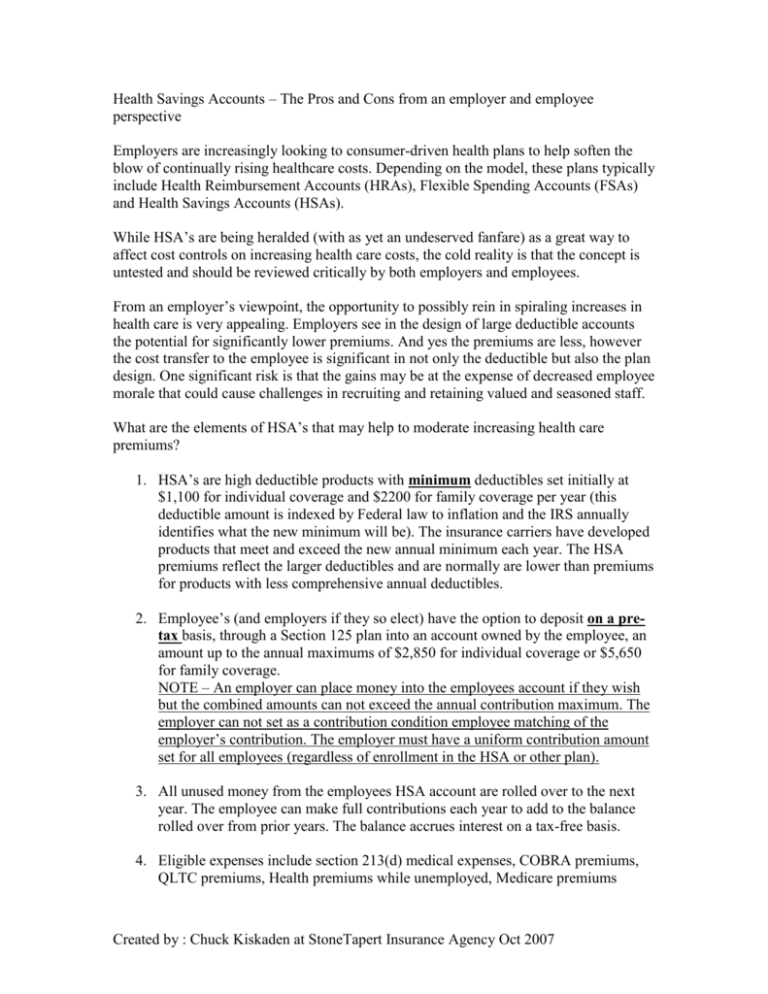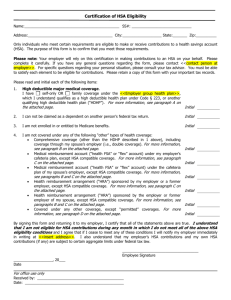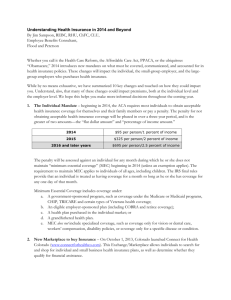Health Savings Accounts – The Pros and Cons from an
advertisement

Health Savings Accounts – The Pros and Cons from an employer and employee perspective Employers are increasingly looking to consumer-driven health plans to help soften the blow of continually rising healthcare costs. Depending on the model, these plans typically include Health Reimbursement Accounts (HRAs), Flexible Spending Accounts (FSAs) and Health Savings Accounts (HSAs). While HSA’s are being heralded (with as yet an undeserved fanfare) as a great way to affect cost controls on increasing health care costs, the cold reality is that the concept is untested and should be reviewed critically by both employers and employees. From an employer’s viewpoint, the opportunity to possibly rein in spiraling increases in health care is very appealing. Employers see in the design of large deductible accounts the potential for significantly lower premiums. And yes the premiums are less, however the cost transfer to the employee is significant in not only the deductible but also the plan design. One significant risk is that the gains may be at the expense of decreased employee morale that could cause challenges in recruiting and retaining valued and seasoned staff. What are the elements of HSA’s that may help to moderate increasing health care premiums? 1. HSA’s are high deductible products with minimum deductibles set initially at $1,100 for individual coverage and $2200 for family coverage per year (this deductible amount is indexed by Federal law to inflation and the IRS annually identifies what the new minimum will be). The insurance carriers have developed products that meet and exceed the new annual minimum each year. The HSA premiums reflect the larger deductibles and are normally are lower than premiums for products with less comprehensive annual deductibles. 2. Employee’s (and employers if they so elect) have the option to deposit on a pretax basis, through a Section 125 plan into an account owned by the employee, an amount up to the annual maximums of $2,850 for individual coverage or $5,650 for family coverage. NOTE – An employer can place money into the employees account if they wish but the combined amounts can not exceed the annual contribution maximum. The employer can not set as a contribution condition employee matching of the employer’s contribution. The employer must have a uniform contribution amount set for all employees (regardless of enrollment in the HSA or other plan). 3. All unused money from the employees HSA account are rolled over to the next year. The employee can make full contributions each year to add to the balance rolled over from prior years. The balance accrues interest on a tax-free basis. 4. Eligible expenses include section 213(d) medical expenses, COBRA premiums, QLTC premiums, Health premiums while unemployed, Medicare premiums Created by : Chuck Kiskaden at StoneTapert Insurance Agency Oct 2007 except for supplemental policies. Any use of the money for non-allowed expenses are taxed as income with an additional 10% penalty. There is no penalty if distributed after death, disability or once the member is eligible for Medicare. There is no substantiation required on claims submitted to your HSA administrator. 5. With HSA’s, there is no first dollar drug coverage (except for identified maintenance drugs for members on disease management regimens). While some disease management drugs can be covered, the deductible must be met for all other drugs before normal drug coverage begins. By Law, Neither the employer or employee can purchase supplemental insurance (or use FSA funds) to pay for the drugs that are subject to the deductible. The Pros and Cons from an EMPLOYER’s perspective PROS 1. Implementing a higher deductible plan should result in lower annual premiums for the products 2. Employees have available an additional option for using pre-tax salary based income to pay for medical deductibles, co-payments and non-covered services. 3. Employers can off-set some of the increased cost to employees by co-contributing pre-taxed corporate revenue to the employees HSA account. 4. A side effect is the lowering of taxable payroll used in calculating workers comp premiums and FICA. CONS 1. Employee Recruitment and Retention Challenges - Employees see moving to higher deductible products as a transfer of cost to them. Because HSA’s are both complicated to understand and new to the market, many employees (and potential employees) may not initially understand the product, and view HSA’s as a dramatic reduction of standard benefits. 2. Even though more than half of small employers already have large deductible products, very few have HSA’s with their limitations on first dollar drug coverage. This will possibly lead to challenges in employee recruitment of older and usually more skilled workers. 3. The employer will need to help the employees locate an administrator to handle the HSA administration. This will result in extra resources dedicated to this issue. 4. If an employer offers a standard section 125 Flexible Spending Account (FSA), this product can not be offered alongside an HSA. a. A special FSA that kicks in after the deductible has been met can be put in place if wanted. Created by : Chuck Kiskaden at StoneTapert Insurance Agency Oct 2007 b. If the employer elects to allow employees the extended 2 ½ months after the anniversary date for submitting bills, this time period can not be used for calculation of FSA contributions. The Pros and Cons from the EMPLOYEE’s perspective PROS 1. Lower premiums for covering dependents 2. Capability to develop a pre-tax account for deductibles, co-pays and non-covered medical services 3. Ability to build a supplemental retirement account using pre-tax income. This will probably appeal to older employees more than others. 4. With many HSA plan designs, once the deductible is met, the employee’s out-ofpocket maximum is close to if not completely fulfilled. CONS 1. Frustration at more cost transfer from the employer 2. Could create dis-incentive to access care due to large deductible 3. Could lead to financial distress due to large deductible and insufficient cash flow to build pre-tax pool of money to cover costs. 4. Confusion on how HSA benefits are integrated with FSA accounts. Created by : Chuck Kiskaden at StoneTapert Insurance Agency Oct 2007







